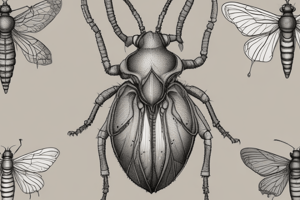Podcast
Questions and Answers
What are the three main parts of an insect's body?
What are the three main parts of an insect's body?
Head, Thorax, and Abdomen
What is the main component of an insect's exoskeleton?
What is the main component of an insect's exoskeleton?
Chitin
How many pairs of wings do most insects have?
How many pairs of wings do most insects have?
Two
What is the process called when insects shed their exoskeleton as they grow and develop?
What is the process called when insects shed their exoskeleton as they grow and develop?
What are the three stages of an insect's life cycle?
What are the three stages of an insect's life cycle?
What type of environment can insects be found in?
What type of environment can insects be found in?
What are the four ecological niches that insects occupy?
What are the four ecological niches that insects occupy?
What is one example of an adaptation that insects have evolved to survive in their environments?
What is one example of an adaptation that insects have evolved to survive in their environments?
Flashcards are hidden until you start studying
Study Notes
Insect Anatomy
- Body structure: Insects have a three-part body consisting of:
- Head
- Thorax
- Abdomen
- Exoskeleton: Made of chitin, a hard, flexible material that provides protection and support
- Sensory organs: Insects have compound eyes, simple eyes, and antennae for sensing their environment
- Wings: Most insects have two pairs of wings (forewings and hindwings) that are attached to the thorax
- Legs: Insects have three pairs of legs, which are used for movement, sensing, and feeding
Insect Life Cycle
- Stages: Insects undergo a process called incomplete metamorphosis, which includes:
- Egg: Insects lay eggs, which hatch into...
- Nymph: A juvenile stage that resembles a small adult, but lacks reproductive organs
- Adult: The final stage, where insects are fully developed and can reproduce
- Molting: Insects shed their exoskeleton as they grow and develop, a process called molting
- Duration: The length of the life cycle varies depending on the species and environmental factors
Insect Habitat
- Diverse environments: Insects can be found in almost every habitat on Earth, including:
- Terrestrial (land)
- Freshwater (rivers, lakes, ponds)
- Marine (oceans)
- Aerial (air)
- Ecological niches: Insects occupy various niches, such as:
- Herbivores (plant-eaters)
- Carnivores (meat-eaters)
- Omnivores (both plant- and meat-eaters)
- Decomposers (break down organic matter)
- Adaptations: Insects have evolved unique adaptations to survive in their environments, such as:
- Camouflage
- Migration
- Hibernation
- Burrowing
Insect Anatomy
- Insects have a three-part body consisting of head, thorax, and abdomen
- The exoskeleton is made of chitin, a hard and flexible material that provides protection and support
- Insects have compound eyes, simple eyes, and antennae for sensing their environment
- Most insects have two pairs of wings (forewings and hindwings) attached to the thorax
- Insects have three pairs of legs used for movement, sensing, and feeding
Insect Life Cycle
- Insects undergo incomplete metamorphosis, which includes egg, nymph, and adult stages
- Eggs hatch into nymphs, which resemble small adults but lack reproductive organs
- Nymphs undergo molting as they grow and develop, eventually becoming adult insects
- Adult insects are fully developed and can reproduce
- The duration of the life cycle varies depending on the species and environmental factors
Insect Habitat
- Insects can be found in almost every habitat on Earth, including terrestrial, freshwater, marine, and aerial environments
- Insects occupy various ecological niches, including herbivores, carnivores, omnivores, and decomposers
- Insects have evolved unique adaptations to survive in their environments, such as camouflage, migration, hibernation, and burrowing
Studying That Suits You
Use AI to generate personalized quizzes and flashcards to suit your learning preferences.



